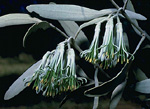 |
This large family has an essentially Southern Hemisphere distribution,
although with some extension north of the Equator in the tropics and around
the Mediterranean. Australia is a centre of diversity, and one or more
species may be found anywhere there are suitable host trees, from mangrove
forests to the mulga woodlands of the arid zone, but absent from Tasmania.
Characteristic features of the family Loranthaceae in Australia include: - parasitic shrubs attached to the branches of their hosts or (the one species of Nuytsia) a small but robust root-parasitic tree.
- leaves usually opposite, often rather thick and with obscure, usually parallel venation, often greyish or with a yellowish tint, borne on brittle stems
- flowers usually brightly coloured, red, yellow or green, regular or zygomorphic, often narrow and more or less tubular, borne in axillary cymes or clusters
- petals 4-6, narrow and strap-like, often rather thick, free or fused; sepals apparently absent or reduced to small teeth on the rim of the ovary
- ovary superior, developing into a fleshy berry with a single stone surrounded by sticky pulp
Description
Evergreen trees, or shrubs, or woody or herbaceous vines climbing by root suckers, or apparent epiphytes. Vegetative reproduction absent or by rhizomes or stolons. Plants partially parasitic on the stems or roots of the host. Stem nodes conspicuously swollen or not; internodes terete, oval or slightly flattened, strongly flattened or distinctly angular. Internal secretions not obvious. Plants glabrous, or with simple, dendritic or stellate, non-glandular, unicellular or uniseriate hairs. Leaves well developed, alternate and spiral, distichous, opposite or in whorls of 3 or 4, petiolate, subsessile or sessile. Stipules absent. Lamina simple, symmetric, filiform, acicular, subulate, linear, lanceolate, ovate, elliptic, oblanceolate, ovate, oblong or orbicular; base cuneate, attenuate, rounded or cordate; margins entire, ±flat, revolute or recurved; venation pinnate, or parallel, with the midrib conspicuous or inconspicuous, and the tertiary venation reticulate or not; surfaces not punctate; leathery or succulent. All the flowers bisexual. Inflorescences terminal, axillary, or apparently cauliflorous or ramiflorous, consisting of capitula, spikes, racemes, corymbs, umbels or dichasial cymes or solitary flowers. Bracts present or absent. Bracteoles present. Pollination by insects or birds. Flowers odourless or fragrant, sessile or stalked. Floral disc present; nectaries present on the disc or the carpels. Perianth of 2 dissimilar whorls, or of 1 whorl only, or all whorls ±similar. Calyx absent or regular; segments fused; calyx weakly dentate, cup-shaped or funnel-shaped, herbaceous or papery. Corolla regular or irregular; segments free or fused, or some fused, others free, with 4–6 petals or lobes, valvate in bud; corolla tubular or curved-tubular, white, cream, yellow, orange, red, pink or green, without contrasting markings, or streaked, spotted, etc, membranous or papery; claws absent; lobes ±entire. Fertile stamens 4–6, alternating with the calyx lobes, at least partly fused to the corolla, free of the ovary and style, distinct from each other, all ±equal. Anthers dorsifixed or basifixed, versatile or not versatile, opening inwards by longitudinal slits, 2- or 4-celled. Ovary inferior. Carpels 3–4, fused; ovary with 1–4 locules. Style terminal, single and unbranched, with the stigma capitate. Ovules undifferentiated; placentation free-central. Fruit a fleshy, indehiscent berry or a drupe; the perianth on the maturing fruit deciduous or dry and persistent. Disseminule micro-surface ±smooth, tuberculate or verrucose, white, cream, yellow, orange, red, green, brown or black, glossy or dull. Seeds 1 per fruit. Aril absent. Cotyledons 2. Embryo straight.
(Note: this description has been generated from the coded data compiled for the key. Any errors in the key data will be reflected in the descriptions.)
A treatment of the family Loranthaceae has been published in:
Flora of Australia 22: 68-131.
Australian genera of Loranthaceae (as recognised for the Flora of Australia)
Amyema
Amylotheca
Atkinsonia
Benthamina
Cecarria
Dactyliophora
Decaisnina
Dendrophthoe
Diplatia
Lysiana
Muellerina
Nuytsia

|
  |

Amyema bifurcatum (flowers)
Photo: G.Leiper © G.Leiper

Amyema cambagei (flowers and fruit)
Photo: G.Leiper © G.Leiper

Amyema gibberula var. gibberula (flowers)
Photo: A.Urban © A.Urban

Amyema hilliana (flowers)
Photo: B.Fuhrer © B.Fuhrer

|
 |
|